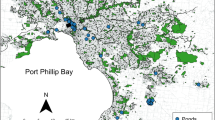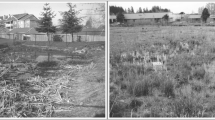Abstract
Context
Habitat loss and habitat fragmentation negatively affect amphibian populations. Roads impact amphibian species through barrier effects and traffic mortality. The landscape variable ‘accessible habitat’ considers the combined effects of habitat loss and roads on populations.
Objectives
The aim was to test whether accessible habitat was a better predictor of amphibian species richness than separate measures of road effects and habitat loss. I assessed how accessible habitat and local habitat variables determine species richness and community composition.
Methods
Frog and tadpole surveys were conducted at 52 wetlands in a peri-urban area of eastern Australia. Accessible habitat was delineated using a highway. Regressions were used to examine relationships between species richness and eleven landscape and local habitat variables. Redundancy analysis was used to examine relationships between community composition and accessible habitat and local habitat variables.
Results
Best-ranked models of species richness included both landscape and local habitat variables. There were positive relationships between species richness and accessible habitat and distance to the highway, and uncertain relationships with proportion cover of native vegetation and road density. There were negative relationships between species richness and concreted wetlands and wetland electrical conductivity. Four species were positively associated with accessible habitat, whereas all species were negatively associated with wetland type.
Conclusions
Barrier effects caused by the highway and habitat loss have negatively affected the amphibian community. Local habitat variables had strong relationships with species richness and community composition, highlighting the importance of both availability and quality of habitat for amphibian conservation near major roads.



Similar content being viewed by others
References
Adams MJ, Richter KO, Leonard WP (1997) Surveying and monitoring amphibians using aquatic funnel traps. In: Olson DH, Leonard WP, Bury RB (eds) Sampling amphibians in lentic habitats. Northwest Fauna Number 4, Society for Northwestern Vertebrate Biology, Olympia, pp 47–54
Allen GR, Midgley SH, Allen M (2003) Field guide to the freshwater fishes of Australia. Western Australian Museum, Perth
Anstis M (2002) Tadpoles of south-eastern Australia: a guide with keys. Reed New Holland, Sydney
Australian Bureau of Statistics (2015) ABS.Stat beta: Nowra (SA2). http://stat.abs.gov.au. Accessed 12 Oct 2015
Baker S, Lauck B (2006) Association of common brown froglets, Crinia signifera, with clearcut forest edges in Tasmania, Australia. Wildl Res 33:29–34
Becker CG, Fonseca CR, Haddad CFB, Batista RF, Prado PI (2007) Habitat split and the global decline of amphibians. Science 318:1775–1777
Beebee TJC (2013) Effects of road mortality and mitigation measures on amphibian populations. Conserv Biol 27:657–668
Brand AB, Snodgrass JW (2010) Value of artificial habitats for amphibian reproduction in altered landscapes. Conserv Biol 24:295–301
Bray JR, Curtis JT (1957) An ordination of the upland forest communities of southern Wisconsin. Ecol Monogr 27:325–349
Bureau of Meteorology (2015) Climate statistics for Australian locations: Nowra RAN Air Station. http://www.bom.gov.au/climate/averages/tables/cw_068076.shtml. Accessed 12 Oct 2015
Carr LW, Fahrig L (2001) Effect of road traffic on two amphibian species of differing vagility. Conserv Biol 15:1071–1078
Clarke KR, Gorley RN (2001) PRIMER v5: user manual/tutorial. PRIMER-E, Plymouth
Cosentino BJ, Marsh DM, Jones KS, Apodaca JJ, Bates C, Beach J, Beard KH, Becklin K, Bell JM, Crockett C, Fawson G, Fjelsted J, Forys EA, Genet KS, Grover M, Holmes J, Indeck K, Karraker NE, Kilpatrick ES, Langen TA, Mugel SG, Molina A, Vonesh JR, Weaver RJ, Willey A (2014) Citizen science reveals widespread negative effects of roads on amphibian distributions. Biol Conserv 180:31–38
Cushman SA (2006) Effects of habitat loss and fragmentation on amphibians: a review and prospectus. Biol Conserv 128:231–240
Daly G (2014) From rags to riches and back again: fluctuations in the green and golden bell frog Litoria aurea population at Nowra on the south coast of New South Wales. Aust Zool 37:157–172
Eigenbrod F, Hecnar SJ, Fahrig L (2008a) The relative effects of road traffic and forest cover on anuran populations. Biol Conserv 141:35–46
Eigenbrod F, Hecnar SJ, Fahrig L (2008b) Accessible habitat: an improved measure of the effects of habitat loss and roads on wildlife populations. Landscape Ecol 23:159–168
Eigenbrod F, Hecnar SJ, Fahrig L (2009) Quantifying the road-effect zone: threshold effects of a motorway on anuran populations in Ontario, Canada. Ecol Soc 14:24. http://www.ecologyandsociety.org/vol14/iss1/art24/
Eigenbrod F, Hecnar SJ, Fahrig L (2011) Sub-optimal study design has major impacts on landscape-scale inference. Biol Conserv 144:298–305
Fahrig L (2003) Effects of habitat fragmentation on biodiversity. Annu Rev Ecol Evol Syst 34:487–515
Fahrig L, Pedlar JH, Pope SE, Taylor PD, Wegner JF (1995) Effect of road traffic on amphibian density. Biol Conserv 73:177–182
Fahrig L, Rytwinski T (2009) Effects of roads on animal abundance: an empirical review and synthesis. Ecol Soc 14:21.http://www.ecologyandsociety.org/vol14/iss1/art21/
Ficken KLG, Byrne PG (2013) Heavy metal pollution negatively correlates with anuran species richness and distribution in south-eastern Australia. Aust Ecol 38:523–533
Findlay CS, Bourdages J (2000) Response time of wetland biodiversity to road construction on adjacent lands. Conserv Biol 14:86–94
Fischer J, Lindenmayer DB (2007) Landscape modification and habitat fragmentation: a synthesis. Glob Ecol Biogeogr 16:265–280
Forman RTT, Alexander LE (1998) Roads and their major ecological effects. Annu Rev Ecol Syst 29:207–231
Gagné SA, Fahrig L (2007) Effect of landscape context on anuran communities in breeding ponds in the National Capital Region, Canada. Landscape Ecol 22:205–215
Gibbs JP (1998) Distribution of woodland amphibians along a forest fragmentation gradient. Landscape Ecol 13:263–268
Glista DJ, DeVault TL, DeWoody JA (2008) Vertebrate road mortality predominantly impacts amphibians. Herpetol Conserv Biol 3:77–87
Graham MH (2003) Confronting multicollinearity in ecological multiple regression. Ecology 84:2809–2815
Guerry AD, Hunter ML (2002) Amphibian distributions in a landscape of forests and agriculture: an examination of landscape composition and configuration. Conserv Biol 16:745–754
Hamer AJ, McDonnell MJ (2008) Amphibian ecology and conservation in the urbanising world: a review. Biol Conserv 141:2432–2449
Hamer AJ, Parris KM (2011) Local and landscape determinants of amphibian communities in urban ponds. Ecol Appl 21:378–390
Hamer AJ, Langton TES, Lesbarrères D (2015) Making a safe leap forward: Mitigating road impacts on amphibians. In: van der Ree R, Smith DJ, Grilo C (eds) Handbook of road ecology. Wiley, Chichester, pp 261–270
Hartel T, Schweiger O, Öllerer K, Cogalniceanu D, Arntzen JW (2010) Amphibian distribution in a traditionally managed rural landscape of Eastern Europe: probing the effect of landscape composition. Biol Conserv 143:1118–1124
Heard GW, Scroggie MP, Malone BS (2012) Classical metapopulation theory as a useful paradigm for the conservation of an endangered amphibian. Biol Conserv 148:156–166
Hels T, Buchwald E (2001) The effect of road kills on amphibian populations. Biol Conserv 99:331–340
Jackson SD, Langen TA, Marsh DM, Andrews KM (2015) Natural history and physiological characteristics of small animals in relation to roads. In: Andrews KM, Nanjappa P, Riley SPD (eds) Roads and ecological infrastructure. Concepts and applications for small animals. Johns Hopkins University Press, Baltimore, pp 21–41
Knutson MG, Sauer JR, Olsen DA, Mossman MJ, Hemesath LM, Lannoo MJ (1999) Effects of landscape composition and wetland fragmentation on frog and toad abundance and species richness in Iowa and Wisconsin, U.S.A. Conserv Biol 13:1437–1446
Kruger DJD, Hamer AJ, Du Preez LH (2015) Urbanization affects frog communities at multiple scales in a rapidly developing African city. Urban Ecosyst 18:1333–1352
Lesbarrères D, Fowler MS, Pagano A, Lodé T (2010) Recovery of anuran community diversity following habitat replacement. J Appl Ecol 47:148–156
Marsh DM, Jaeger JAG (2015) Direct effects of roads on small animal populations. In: Andrews KM, Nanjappa P, Riley SPD (eds) Roads and ecological infrastructure. Concepts and applications for small animals. Johns Hopkins University Press, Baltimore, pp 42–56
Mazerolle MJ (2004) Amphibian road mortality in response to nightly variations in traffic intensity. Herpetologica 60:45–53
McCarthy MA (2007) Bayesian methods for ecology. Cambridge University Press, Cambridge
McCune B, Grace JB (2002) Analysis of ecological communities. MjM Software Design, Gleneden Beach
Parris KM (2006) Urban amphibian assemblages as metacommunities. J Anim Ecol 75:757–764
Pellet J, Guisan A, Perrin N (2004) A concentric analysis of the impact of urbanization on the threatened European tree frog in an agricultural landscape. Conserv Biol 18:1599–1606
Pellet J, Schmidt BR (2005) Monitoring distributions using call surveys: estimating site occupancy, detection probabilities and inferring absence. Biol Conserv 123:27–35
Pillsbury FC, Miller JR (2008) Habitat and landscape characteristics underlying anuran community structure along an urban–rural gradient. Ecol Appl 18:1107–1118
Pope SE, Fahrig L, Merriam HG (2000) Landscape complementation and metapopulation effects on leopard frog populations. Ecology 81:2498–2508
Price SJ, Marks DR, Howe RW, Hanowski JM, Niemi GJ (2004) The importance of spatial scale for conservation and assessment of anuran populations in coastal wetlands of the western Great Lakes, USA. Landscape Ecol 20:441–454
Pyke GH, White AW (2000) Factors influencing predation on eggs and tadpoles of the endangered green and golden bell frog Litoria aurea by the introduced Plague Minnow Gambusia holbrooki. Aust Zool 31:496–505
Rytwinski T, Fahrig L (2012) Do species life history traits explain population responses to roads? A meta-analysis. Biol Conserv 147:87–98
Rytwinski T, Fahrig L (2015) The impacts of roads and traffic on terrestrial animal populations. In: van der Ree R, Smith DJ, Grilo C (eds) Handbook of road ecology. Wiley, Chichester, pp 237–246
Smallbone LT, Luck GW, Wassens S (2011) Anuran species in urban landscapes: relationships with biophysical, built environment and socio-economic factors. Landsc Urban Plan 101:43–51
Spiegelhalter DJ, Best NG, Carlin BP, van der Linde A (2002) Bayesian measures of model complexity and fit. J R Stat Soc B 64:583–639
Spiegelhalter D, Thomas A, Best N, Lunn D (2007) Open BUGS user manual. Version 3.0.2. MRC Biostatistics Unit, Cambridge
Stockwell MP, Clulow J, Mahony MJ (2010) Host species determines whether infection load increases beyond disease-causing thresholds following exposure to the amphibian chytrid fungus. Anim Conserv 13(Suppl. 1):62–71
Sutherland RW, Dunning PR, Baker WM (2010) Amphibian encounter rates on roads with different amounts of traffic and urbanization. Conserv Biol 24:1626–1635
ter Braak CJF (2000) Ordination. In: Jongman RHG, ter Braak CJF, van Tongeren OFR (eds) Data analysis in community and landscape ecology. Cambridge University Press, Cambridge, pp 91–173
ter Braak CJF, Šmilauer P (1998) CANOCO reference manual and user’s guide to Canoco for Windows: software for canonical community ordination (version 4). Microcomputer Power, Ithaca
Tozer MG, Turner K, Keith DA, Tindall D, Pennay C, Simpson C, MacKenzie B, Beukers P, Cox S (2010) Native vegetation of southeast NSW: a revised classification and map for the coast and eastern tablelands. Cunninghamia 11:359–406
Trombulak SC, Frissell CA (2000) Review of ecological effects of roads on terrestrial and aquatic communities. Conserv Biol 14:18–30
Van Buskirk J (2005) Local and landscape influence on amphibian occurrence and abundance. Ecology 86:1936–1947
Wellborn GA, Skelly DK, Werner EE (1996) Mechanisms creating community structure across a freshwater habitat gradient. Annu Rev Ecol Syst 27:337–363
Wintle BA, Elith J, Potts JM (2005) Fauna habitat modelling and mapping: a review and case study in the Lower Hunter Central Coast region of NSW. Aust Ecol 30:719–738
Acknowledgments
I thank Josie Stokes and Shaun Walsh (New South Wales Roads and Maritime Services) for financial and logistical assistance; JS also provided valuable comments on the manuscript. Lee Harrison, Rodney Wattus, Briony Mitchell, Joanne Ainley and Caroline Wilson assisted with fieldwork. Rodney van der Ree provided support with initial planning of the study. Amy Hahs provided GIS support and helpful comments on the manuscript. I thank the landowners who kindly assisted with access to their properties. Phil Craven (NSW National Parks and Wildlife Service) provided information on local site conditions prior to fieldwork. Steve Swearer and James Shelley provided assistance with fish identification. The Baker Foundation provided additional support. This study was conducted under NSW National Parks and Wildlife Service scientific licence number SL101064, and NSW Department of Primary Industries animal ethics approval number 12/4900.
Author information
Authors and Affiliations
Corresponding author
Electronic supplementary material
Below is the link to the electronic supplementary material.
Rights and permissions
About this article
Cite this article
Hamer, A.J. Accessible habitat delineated by a highway predicts landscape-scale effects of habitat loss in an amphibian community. Landscape Ecol 31, 2259–2274 (2016). https://doi.org/10.1007/s10980-016-0398-2
Received:
Accepted:
Published:
Issue Date:
DOI: https://doi.org/10.1007/s10980-016-0398-2




